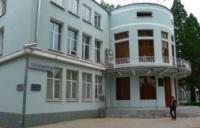You are here
Justice building in Dushanbe.


Excursion tourism in Dushanbe.
"Where the sweat of zeal has been shed by a man,
Man will reap the fruits of immortality"
Zahir al-Din Muhammad Babur.
Ethnographic tourism in Dushanbe.
Building of the Ministry of Justice is located at 25 Rudaki Avenue and at the corner of Academician Radjapov Street, 100 meters southwest of the 800th Anniversary of Moscow Square in Dushanbe. In 1930, the building of the People's Commissariat of Agriculture was completed, located at the corner of Lenin and Kuibyshev streets (architect Petr Vaulin).
Undoubtedly, this building is the most striking example of constructivism in Dushanbe. It once housed the People's Commissariat of Agriculture of the Tajik SSR, which led the work on the reconstruction of agriculture and supervised the construction of state farms and collective farms.
In the 1930s, architect Pyotr Vaulin created Stalinabad's landmark buildings in the constructivist style, which still serve the townspeople. The most famous and currently existing of them are the Farmer's House (V. Mayakovsky Theatre), the building of the Council of People's Commissars of the Tajik SSR (opposite the city hall), the People's Commissariat of Agriculture (Ministry of Justice of the Republic of Tatarstan) and many other buildings.
Unfortunately, not a single photograph has survived to this day of the person who, at the head of a group of young architects from Leningrad, completed a topographic survey in 1926 and drew up a plan for the future capital of Tajikistan, drawing its first streets and avenues.
Petr Ivanovich Vaulin was born in 1902 in St. Petersburg. Graduated from the Institute of Civil Engineers. He worked in Leningrad, Vologda, Minsk. When he was offered to go to Central Asia and build the capital of Soviet Tajikistan, he agreed without hesitation.
Although the climatic and natural features of the place for the future city were completely unexplored, high seismicity and treacherous subsidence soils frightened, it was not in the nature of Peter Vaulin to retreat. And already on April 27, 1927, the Council of People's Commissars of the republic adopted a resolution drawn up by P. Vaulin "On the construction of the city of Dushanbe", which obliged the city executive committee to stop unplanned construction and take measures to draw up a "preliminary planning project for at least two or three streets."
In 1929, P. Vaulin met in Moscow the great architect of the 20th century, Le Corbusier, and was imbued with his idea of the "Green City", "Garden City". Soon beautiful parks, gardens, squares, shady boulevards, alley streets appeared in the capital of Soviet Tajikistan.
In 1945, Petr Ivanovich Vaulin died and was buried in the Orthodox cemetery in Dushanbe. I really want to believe that the authorities of our city will perpetuate the name of one of its founders - Peter Vaulin, naming one of the streets of Dushanbe after him.
Geographical coordinates of building of Ministry of Justice in Dushanbe: N38°34'03 E68°47'33
Authority and photos:
Used photographs from the Central State Archive of the Republic of Tatarstan and personal photographs of Gafur Shermatov, a historian.







